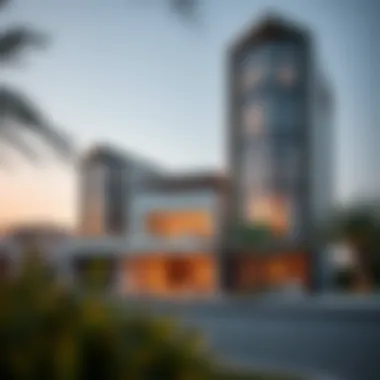Understanding Currency Conversion: USD to AED


Intro
When it comes to international finance, few concepts hold as much significance as currency conversion. For Americans seeking to make their mark in the dynamic market of the United Arab Emirates, understanding the relationship between the United States Dollar (USD) and the United Arab Emirates Dirham (AED) becomes crucial. Converting 96 USD to AED isn't just a numbers game; it represents a doorway into opportunities for investment, travel, and commerce in one of the Middle East's most vibrant economies.
In this article, we will explore how exchange rates function between these two currencies, providing insights not only for individual travelers but also for investors and entrepreneurs looking to navigate the bustling economic landscape of Dubai. We'll break down the complexities of currency conversion, focusing on factors that drive exchange rates and strategies to maximize your financial advantage.
As we delve into the nuances of converting USD to AED, we'll look at current trends in Dubai's real estate market, analyze property valuations, offer tips for investments, and consider the implications for expatriates and locals alike.
So, let’s take this opportunity and peel back the layers to give you a clear picture of what it means to convert currency, the importance it holds, and the potential benefits waiting for you on the other side of the exchange.
Foreword to Currency Conversion
Currency conversion is a prime aspect of global economics, touching on finances, trade, and individual transactions. In today's interconnected world, understanding currency conversion, particularly between the United States Dollar (USD) and the United Arab Emirates Dirham (AED), is crucial for anyone involved in international dealings or looking to invest abroad.
Understanding Currency Exchange
The essence of currency exchange lies in the need to transact across borders. When you exchange one currency for another, you rely on an exchange rate, a figure reflecting how much of one currency you need to spend to obtain another.
In the case of USD and AED, awareness of exchange rates can affect investment decisions, individual travel budgets, and even everyday purchases while abroad. For a traveler heading to Dubai, knowing how many Dirhams a dollar buys isn't just informative; it's foundational to managing expenses.
Not everything can be captured through average exchange rate values. Personal sentiments, sudden market shifts or even unforeseen political events can impact how currencies trade against one another at any given moment. Everyday users might experience these fluctuations first-hand, from that extra Dirham they need for a bus ride to the couple of dollars saved on dinner at a local restaurant.
Importance of Accurate Conversion
Accuracy in currency conversion cannot be overstated. Miscalculating an exchange rate, even slightly, can lead to substantial financial consequences. Picture this: an investor planning on purchasing real estate in Dubai looks at the current conversion rate and decides to use a rough estimate instead of the actual figure available. If they mistook the rate by a few Dirhams, the lost opportunity or overspent sum can quickly multiply, especially in real estate where properties can range into the millions of AED.
Moreover, international business transactions hinge on precise conversions. A company exporting goods to the UAE needs to ensure their pricing strategy reflects accurate and timely exchange rates to avoid unexpected losses due to miscalculation. They wouldn't want to find out later that their profits shrank because they didn't account for a recent drop in the dollar's value against the Dirham.
In summary, understanding currency conversion is not merely about numbers on a screen; it is about making informed financial decisions that can impact travel, investments, and business operations. It’s a vital tool in the world we live in where financial landscapes are changing faster than a blink of an eye.
"The truth in currency exchange is as fluid as the market it operates in. A reliable grasp on conversion is what sets successful investors apart from the rest."
In the next sections, we will delve into the specifics of the USD to AED exchange rate, examining recent trends, practical conversion calculations, and factors influencing these rates.
Current Exchange Rate: USD to AED
The current exchange rate between the United States Dollar (USD) and the United Arab Emirates Dirham (AED) is a key element for anyone looking to engage in financial transactions, investments, or even simply planning a trip to the UAE. This rate constantly shifts based on various economic factors, making it essential to understand its fluctuating nature. Grasping this concept can lead to more strategic financial choices, avoiding unnecessary losses due to unfavorable conversion rates.
Recent Trends in USD/AED Rate
When you eyeball the recent trends in the USD to AED conversion, you’ll notice that the exchanges have taken a few twists and turns. Over the last year, the rate has been relatively stable, hovering around the 3.67 mark. This stability gives a certain comfort to investors and travelers alike, as they can expect somewhat consistent purchasing power.
Some market peculiarities have emerged, influenced by geopolitical developments and overall global economic conditions. For instance, the fluctuating oil prices and their impact on the UAE's economy show how intertwined these factors can be.
A look into several months of data will reveal notable spikes during critical periods in the global economic landscape. For example, last summer witnessed a dip in the dollar's strength, nudging the rate momentarily closer to 3.80 AED. However, savvy investors recognized this as a potential buying opportunity, predicting corrections in the forex market.
In summary, keeping tabs on the recent trends allows individuals to make timely decisions, sorting the wheat from the chaff in the financial markets.
Historical Context of the Exchange Rate
Understanding the historical context of the USD/AED exchange rate sheds light on its current state. The Dirham has been pegged to the dollar since 1997, and this fixed exchange policy has provided persistent stability. While the economic landscape has seen its ups and downs, the pegged nature has made it easy for businesses to forecast expenses.
Historically, the exchange rate hovered around 3.66 to 3.68 for most of the last two decades, reflecting a lack of major drastic changes. However, crises like the 2008 financial meltdown created bubbles in exchange rates, which led to short-lived volatility.
Reflecting on past data, here are a few succinct takeaways:
- Pre-2008 Period: Stable at about 3.67 AED, a comfortable zone for traders.
- 2008 Financial Crisis: Currency fluctuations, hitting 4.00 AED briefly due to panic.
- Post-Crisis Recovery: Gradually restored to 3.67, showing resilience against shocks.
Recognizing these historical shifts can inform future expectations, sharpening the focus on what to watch for in trends moving forward. Investors can apply these insights not just for currency conversion but also to strategize investments in the real estate sector, where currency valuations significantly impact property prices.
The fixed exchange rate policy between the USD and AED has provided remarkable stability, minimizing risks for traders and investors alike.


By wrapping our heads around recent trends and historical context, we equip ourselves with a better understanding of how this exchange rate functions and how we might anticipate its movements.
Converting USD to AED
When diving into the complexities of currency conversion, one might wonder why a small sum, like 96 USD, deserves significant attention. Well, in the grand scheme of things, this figure serves as a practical benchmark for everyday transactions that many folk may encounter. Understanding how to convert this amount into AED isn’t just a trivial exercise; it can influence your budgeting, purchasing decisions, and even investment strategies in the thriving market of Dubai.
Whether you're planning a holiday, considering long-term relocation, or just examining personal finances, knowing how to properly convert USD to AED can be invaluable. Every dollar counts, and for expatriates or travelers, understanding currency conversion not only helps with expenses but also opens up avenues for smarter financial choices.
In this section, we’ll explore how to convert 96 USD to AED through a clear calculation method, followed by practical examples that illustrate the conversion process in real-world scenarios.
Calculation Method
To convert USD to AED, the fundamental step is to use the current exchange rate. Assuming one is aware of the exchange rate—as it fluctuates constantly due to market dynamics, it’s wise to check a reputable source before making any conversions.
To illustrate:
- Find the Current Exchange Rate: Check a reliable financial news site or use a currency converter app. As an example from today’s rates (hypothetical), let’s say the exchange rate is 3.67 AED for 1 USD.
- Perform the Conversion Calculation: Multiply the amount you have in USD by the current exchange rate to find its equivalent in AED.This can be expressed with a simple formula:Amount in AED = Amount in USD x Exchange RateAmount in AED = 96 x 3.67 Amount in AED = 352.32
Practical Examples of Conversion
Now that we’ve established a calculation method, let’s put it into context with some practical examples that reflect real-world transactions:
- Travel Expenses: Imagine a traveler planning to spend a week in Dubai. If they have 96 USD, converting it would yield about 352.32 AED to cover hotel costs or meals. Understanding this helps in budgeting, making sure they have adequate funds for their trip.
- Expatriate Planning: For someone new to Dubai, needing to establish a local budget is crucial. If, for instance, the rent for a modest apartment is around 2000 AED a month, knowing how to convert their salary from USD to AED ensures they can secure a place without unexpected financial strain.
- Investing in Real Estate: Assume an investor from the US is looking at properties priced at 1,000,000 AED. They need to know how much that is in USD. By converting the AED amount back to USD using the inverse of the exchange rate, they can make informed decisions about their investment.
These scenarios illustrate that the conversion process and comprehension of the value of 96 USD can significantly impact personal expenditures and investment outlooks.
Understanding the exchange rate is like knowing the score in a game; it’s crucial for playing effectively—especially in a vibrant market like Dubai.
Factors Influencing Exchange Rates
Understanding the factors that influence exchange rates is crucial for anyone involved in financial transactions or investments. The exchange rate between the USD and AED doesn’t just float in the ether; it is shaped by numerous economic parameters, political conditions, and global market dynamics. A keen grasp of these elements can provide a more informed perspective whether you're a real estate investor considering a property in Dubai, or a homebuyer trying to get the best deal on your currency conversion.
Economic Indicators
Economic indicators are key metrics that reflect the overall health of an economy. They can have a pronounced effect on currency value. When we talk about the USD to AED exchange rate, several indicators play a significant role:
- Interest Rates: Central banks, like the Federal Reserve in the U.S., update interest rates to manage economic growth. If the Fed raises rates, the USD tends to strengthen against the AED due to higher returns on investments, attracting foreign capital.
- Inflation Rates: A nation with a lower inflation rate tends to have an appreciating currency. The purchasing power in countries like the United States compared to the UAE can lead to fluctuations in the USD/AED rate.
- Gross Domestic Product (GDP): A growing economy typically enhances currency strength. When U.S. GDP shows robust growth, it could lead to an increase in the value of the USD relative to the AED, as investors gain confidence in the U.S. economy.
These economic indicators are not just numbers; they tell a story of financial health and can deeply impact currency values.
Political Stability and Its Impact
Political climate stands as another pillar influencing exchange rate stability. Political events in the U.S. or UAE can sway investor confidence and impact the USD/AED exchange rate:
- Elections and Policy Changes: A shift in political leadership often results in variations in economic policy. Investors closely watch elections in both countries. If a new administration is perceived to be unstable or unpredictable, the USD may weaken against the AED as confidence wanes.
- Geopolitical Events: Issues like trade agreements, conflicts, or sanctions can send ripples through currency markets. For instance, if the U.S. engages in a conflict that raises tensions in global markets, its currency could take a hit.
In essence, the stability of a government's policies and the overall political environment can greatly determine how currencies trade against each other.
Global Market Influences
The interconnectivity of global markets can lead to significant ripple effects on currency values. As investors are not confined to a single market, larger economic shifts can have far-reaching impacts:
- Supply and Demand Dynamics: Currencies are ultimately traded much like any other commodity. When there is a high demand for USD in the global market—perhaps due to its safety as a reserve currency—its value can rise relative to the AED.
- Commodity Prices: Many economies heavily depend on commodities. For instance, if oil prices surge, it could lead to a strengthening of the AED since the UAE is a significant oil exporter. Conversely, as oil prices drop, so too may the AED.
- Interest in Emerging Markets: As more investors turn their gaze towards emerging markets like those in the Middle East, the dynamics of supply and demand shift, contributing to fluctuations in USD/AED exchange rates.
"Understanding these factors is essential not only for making informed currency conversion choices but also for strategic investment planning in regions where USD and AED are relevant."
In summary, recognizing how economic indicators, political stability, and global market influences play a role in currency exchange can empower you to make wiser financial decisions, particularly when handling transactions between USD and AED.
Practical Tips for Currency Conversion


Understanding currency conversion is crucial, particularly when dealing with varying rates between the dollar and dirham. Knowing how to navigate the world of currency exchange helps you to avoid pitfalls and maximize returns.
Choosing the Right Exchange Provider
Selecting the right exchange provider can significantly influence the amount you receive in AED for your USD. Various entities offer exchange services, such as banks, currency exchange kiosks, and online platforms. Here are some considerations:
Consider Reputation and Trustworthiness
When looking for an exchange provider, prioritizing reputation is non-negotiable. Not all providers are created equal. Research the provider’s background and read customer reviews. Websites like Reddit and trustpilot.com can provide insights into users' experiences.
Compare Rates
Exchange rates can fluctuate often throughout the day. It's wise to compare rates from multiple providers before making a conversion. Using a site like XE.com can give you a quick overview of current rates across different services. A small number can make a big difference, especially when converting large sums.
Fees and Commissions
Keep an eye on hidden fees and commissions that may apply. Some providers advertise favorable exchange rates but impose high service charges, which might negate the benefits. Always ask for a complete breakdown of fees, so you won't be caught off guard.
As they say, 'A penny saved is a penny earned.' This holds true in currency conversion too. Every little bit matters.
Avoiding Unfavorable Rates
To steer clear of unfavorable rates, a combination of timing and informed decision-making is key. Here’s how to enhance your chances:
Monitoring Market Trends
Staying updated with market trends can help you identify the right moments to exchange. Factors like economic news, political stability, and global events can influence exchange rates. Subscribing to financial news platforms or using apps that notify you of significant changes can be valuable.
Timing Your Conversion
Some economic patterns lend themselves to seasonal fluctuations. There may be points during the fiscal year where the USD strengthens against the AED or vice versa. Observing these trends can help you time your conversion for maximum benefit.
Set Up Alerts
Many financial service platforms allow users to set up alerts for specific exchange rates. This means you won’t have to keep checking manually — when the rate hits your target, you’ll be notified. This feature can often be seen in major banking apps or websites like OANDA.com.
Relevance for Real Estate Investors
When considering investing in real estate, particularly in markets like Dubai, understanding currency conversion becomes a cornerstone of sound financial decision-making. The USD to AED exchange rate is not just a numeric detail; it shapes investment costs, influences property market dynamics, and affects overall returns on investment. Among investors eyeing properties in the Emirates, knowing how to navigate this conversion helps in budgeting, forecasting gains, and comprehending the broader economic milieu.
Understanding Investment Costs in AED
In the context of real estate, the AED stands as the local currency, making it essential for foreign investors to grasp their dollar's strength compared to the Dirham. Let’s break down the factors that mold investment costs.
- Property Prices: When priced in AED, the value of US dollars fluctuating against the Dirham can directly influence the actual price an investor pays. A weaker dollar means a higher cost in AED, while a stronger dollar can propel purchasing power.
- Transaction Fees: Various service fees, often tied to local currency, can become hefty, especially if the exchange rate isn’t in favor of the investor. Understanding these fees is vital for creating a well-rounded budget.
- Financing Options: Local banks may offer loans in AED which means that if you’re acquiring property while holding dollars, understanding conversion is crucial not just for the down payment but also for ongoing mortgage payments.
Insight into the investment landscape — including the pricing strategies of real estate developers and market demands — further highlights the necessity of paying attention to these conversion rates.
Impact of Currency Fluctuation on Investments
In the fast-paced environment of Dubai’s real estate market, currency fluctuations can tip the scales between profit and loss. Here’s how these fluctuations can have ripple effects:
- Valuation Changes: Properties can be worth more or less as the exchange rate shifts. This means an investor might need to recalibrate their expectations based on current USD to AED rates before entering the market.
- Capital Gains: When it comes time to sell, the value appreciated in AED might not equal the returns when translated back into dollars. An investor could find themself at a loss if the dollar weakens by the time they exit.
- Cost of Living: Fluctuations affect the cost of living for expatriates. Thus, as the currency fluctuates, the budget allocated to living expenses can impact rental returns.
Fluctuations also invite risk, making it essential for investors to remain cognizant of relevant economic indicators. Staying updated through trusted financial news sources might help you anticipate potential shifts in the exchange rate.
"In the currency exchange game, even a small change can bring about a big impact on your real estate portfolio."
Thus, knowing how to track everything from interest rates to economic policies will lead to better foresight in investments. Armed with this knowledge, investors can navigate Dubai’s real estate landscape with much more confidence.
For more information about current economic conditions and their effects on currency rates, consider visiting trusted sources like Investopedia or Bloomberg.


Insights for Expatriates Planning to Settle in Dubai
As more expatriates envision a new life in Dubai, understanding the intricacies of currency conversion becomes essential. This section explores how the conversion rate between the US Dollar (USD) and the United Arab Emirates Dirham (AED) plays a significant role in planning finances for living and investing.
Moving to a new country like the UAE comes with a bundle of financial implications. Settling down in Dubai can offer immense economic opportunities, but the nuances of budgeting and currency exchange can easily trip up newcomers.
When planning to move, one of the most pressing concerns for expatriates is budgeting for living expenses. This involves not just understanding the cost of everyday goods and services but also anticipating how these costs translate from one currency to another. Whether it’s paying rent, buying groceries, or dining out, making sense of prices in AED is crucial.
The current exchange rate directly affects how much your USD can stretch in the Emirates.
Budgeting for Living Expenses
Expatriates should meticulously consider their monthly living expenses in Dubai, estimated in AED. Typical costs include accommodation, utilities, groceries, and healthcare. Having a firm grasp on these expenses can facilitate smoother financial transitions.
- Accommodation: Renting a one-bedroom apartment in a popular area can range from 3,000 to 15,000 AED per month, depending on location and amenities. Knowing how much USD converts to AED allows expatriates to set realistic expectations.
- Utilities: Utility bills can vary greatly. Expect to pay anywhere between 400 to 1,100 AED for electricity, water, and internet, depending on usage.
- Groceries: Weekly grocery shopping for a small family can cost between 300 to 600 AED. Understanding current exchange rates can aid in effective budgeting for these day-to-day expenses.
- Healthcare: While the UAE offers world-class healthcare, it can be pricey without insurance. Monthly premiums can range widely, but planning for 500 to 1,200 AED is often wise.
Given these expenses, expatriates should strive to maintain an ongoing awareness of the exchange rate. Setting aside funds in USD and converting them at strategic times can lead to savings.
Navigating Exchange and Conversion Services
Understanding the various options available for currency conversion is just as important as budgeting itself. Different exchange providers can offer widely varying rates and fees, which can significantly impact your finances.
- Banks: Major banks often provide reliable services, but they might not offer the most competitive rates. It’s wise to check multiple banks to compare costs.
- Currency Exchange Services: Dedicated currency exchange outlets may provide better rates than banks. However, ensure that you’re using reputable services to avoid rip-offs.
- Online Platforms: Platforms like TransferWise or OFX can also be good alternatives, especially for larger sums, as they may charge lower fees.
- ATMs: Withdrawing AED directly from ATMs using a foreign card can be convenient, but watch out for potential transaction fees and unfavorable exchange rates.
- Local Markets: Some expatriates use informal money exchanges, but proceed with caution. Verify the rates to ensure they are fair; this is where the risk of being shortchanged lurks.
Overall, setting up a clear strategy for budgeting and choosing the right conversion services can significantly alleviate financial pressure for expatriates.
Understanding your financial landscape is crucial. The more you know about currency rates and local costs, the better equipped you'll be to make informed decisions once you land.
As expats get familiar with Dubai's cost of living and exchange services, they can maximize their USD and ensure that they have a comfortable and sustainable lifestyle in this vibrant city.
The Future of USD/AED Exchange Rates
The world of currency exchange is an ever-evolving landscape, and the relationship between the United States Dollar (USD) and the United Arab Emirates Dirham (AED) is no exception. Understanding the future of this exchange rate is crucial for various stakeholders, including investors, realtors, homebuyers, and expatriates. As changes in global dynamics can alter economic situations, having insights into forecasting trends, potential impacts from global events, and the overall trajectory of USD/AED rates can aid in making informed financial decisions.
Forecasting Trends and Predictions
When forecasting the trends of the USD/AED exchange rate, various economic indicators come into play. These indicators include inflation rates, interest rates, and employment statistics. For example, if the U.S. economy experiences growth, it may lead to a stronger USD, which could directly affect the exchange rate against the AED. Recent reports suggest a modest growth prediction in the U.S. economy, which could lead to a more robust USD in the future.
- Analysts often use historical data to develop models that predict future exchange rates. These models can incorporate:
- Economic growth rates.
- Changes in monetary policy from the Federal Reserve or the Central Bank of the UAE.
- Current events that may influence market confidence.
Additionally, the relationship between oil prices and the AED cannot be overlooked. Given that the UAE is a major oil-exporting nation, fluctuations in oil prices often correlate with the strength of the AED. If oil prices rise, the UAE's economy may benefit, potentially stabilizing or even strengthening the AED in relation to the USD.
"Economic forecasting is not about predicting the future; it's about providing a framework that helps people make informed decisions."
Potential Impact of Global Events
Global events, be they political, economic, or natural disasters, can significantly impact exchange rates in ways that are often difficult to predict. For instance, geopolitical tensions in the Middle East can lead to uncertainty in the markets, favoring safe-haven currencies like the USD over the AED. A classic case is the ongoing challenges related to oil supply, where disruptions often drive investors toward the dollar, thus affecting the currency pair's exchange rate.
Some key factors to monitor include:
- Geopolitical Tensions: Conflicts or political instability can cause investors to seek security in USD.
- Trade Agreements: New trade pacts (or disputes) can shift investor confidence, influencing currency values positively or negatively.
- Global Economic Policies: The impact of decisions made in large economies, including China and the EU, can resonate across the globe and affect USD/AED directly.
Finale
In wrapping up the exploration of currency conversion from the United States Dollar (USD) to the United Arab Emirates Dirham (AED), it becomes evident that understanding this exchange is of paramount importance for a range of stakeholders, from investors to expatriates. As currency fluctuations can significantly impact both investment decisions and everyday expenses, a thorough grasp of this aspect can aid in navigating financial landscapes more effectively.
Summarizing Key Takeaways
- The Dynamics of Exchange Rates: Exchange rates between currencies like USD and AED are influenced by several factors that include economic indicators, political stability, and global market trends.
- Practical Conversion Strategies: Employing effective currency conversion strategies is crucial for securing favorable rates, which ultimately affects the purchasing power in a foreign currency.
- Investment Implications: Investors should be acutely aware of currency fluctuations. An understanding of the trends can guide them in timing their investments to avoid unnecessary losses.
- Expatriate Considerations: For those planning to relocate to Dubai, awareness of local currency dynamics may influence budgeting decisions significantly.
Encouraging Informed Financial Decisions
Arming oneself with knowledge about the USD to AED conversion isn’t merely about knowing the math behind it—it encompasses making savvy financial decisions that correspond to changing market conditions.
- Keeping Abreast of Market Trends: Regularly monitoring the economic landscape informs when to convert money, thus maximizing value.
- Engaging with Financial Experts: Consulting with financial advisors or analysts can provide tailored strategies relevant to the current economic climate, enhancing the decision-making process.
- Utilizing Technology: Leveraging apps and platforms that track exchange rates can streamline the conversion process while also alerting users to advantageous transactions.
By synthesizing all these elements, readers from various backgrounds can make informed choices, whether for investments or personal finance, thereby building a better understanding of the interplay between USD and AED.











